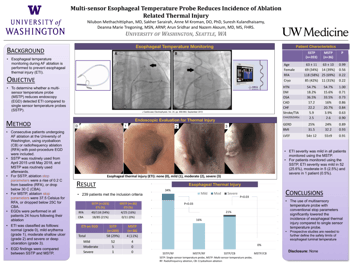
Incidence of Asymptomatic Oesophageal Lesions After Atrial Fibrillation Ablation Using an Oesophageal Temperature Probe with Insulated Thermocouples: A Comparative Controlled Study
Author Information: Philipp Halbfass, Patrick Müller, Karin Nentwich, Joachim Krug, Markus Roos, Karsten Hamm, Sebastian Barth, Attila Szöllösi, Andreas Mügge, Bernhard Schieffer, and Thomas Deneke
Heart Center Bad Neustadt, Clinic for Interventional Electrophsiology, Bad Neustadt an der Saale, Germany
University Hospital Bergmannsheil, Ruhr-University Bochum, Bochum, Germany
Department of Cardiology and Angiology, Philipps University Marburg, Marburg, Germany
ABSTRACT:
AIMS: Oesophageal probes to monitor luminal oesophageal temperature (LET) during atrial fibrillation (AF) catheter ablation have been proposed, but their effects remain unclear. Aim of this study is to evaluate the effects of an oesophageal temperature probe with insulated thermocouples.
METHODS AND RESULTS: Patients with symptomatic, drug-refractory paroxysmal or persistent AF who underwent left atrial radiofrequency (RF) catheter ablation were prospectively enrolled. Patients were ablated using a single-tip RF contact force ablation catheter. An intraluminal oesophageal temperature probe was used in Group 1. In Group 2, patients were ablated without LET monitoring. Assessment of asymptomatic endoscopically detected oesophageal lesions (EDEL) was performed by oesophagogastroduodenoscopy (EGD) in all patients. Eighty patients (mean age 63.7+10.7 years; men 56%) with symptomatic, drug-refractory paroxysmal (n 1⁄4 28; 35%) or persistent AF were included. Group 1 and Group 2 patients (n 1⁄4 40 in each group) were comparable in regard to baseline characteristics, but RF duration on the posterior wall was significantly shorter in Group 1 patients. Overall, seven patients (8.8%) developed EDEL (four ulcerations, three erythema). The incidence of EDEL in Group 1 and Group 2 patients was comparable (7.5 vs. 10%, P 1⁄4 1.0). No major adverse events were reported in both groups.
CONCLUSION: According to these preliminary results, the use of oesophageal temperature probes with insulated thermocouples seems to be feasible in patients undergoing AF RF catheter ablation. The incidence of post-procedural EDEL when using a cut-off of 398C is comparable to the incidence of EDEL without using a temperature probe.
PUBLICATION INFORMATION:
Published in EP Europace, Volume 19, Issue 3
March 2017
Pages 385 – 391

.svg)
.svg)
.svg)


